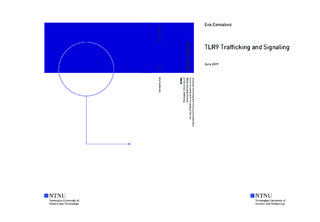| dc.description.abstract | Toll-like Receptor 9 (TLR9) is an endosomal receptor found highly expressed in B cells and plasmacytoid dendritic cells (pDCs). It is activated by unmethylated CpG DNA and synthetic CpG oligodeoxyribonucleotides (ODNs) to produce pro-inflammatory cytokines (TNFα, IL-12) and type I interferons (IFNs). It senses viral and bacterial pathogens and activates adaptive immune responses. Dysregulation of TLR9 signaling can lead to progression and regression of various cancers and autoimmune diseases. Thus, modulation of TLR9 activity is an attractive target for immunotherapy. Due to scarcity of pDCs in the blood and a lack of a suitable model for studying of TLR9, knowledge about this receptor is lacking. The goal of this project was to characterize two experimental model cell lines (THP-1 TLR9 mCherry and CAL-1 TLR9 mCherry) for in vitro studies of TLR9, use them to study TLR9 expression, trafficking and signaling in pDC-like cells and investigate the role of Rab11a and Rab39a in these processes. Both cell lines express doxycycline-inducible TLR9 mCherry. The results showed that IL-4, GM-CSF-differentiated THP-1 TLR9 mCherry cells resemble immature dendritic cells in their ability to induce IFNβ1 and TNFα in response to CpG ODNs. Undifferentiated CAL-1 TLR9 mCherry cells potently induced IFNβ1 in response to CpG ODNs, validating their pDC-like properties. In IL-4, GM-CSF-differentiated THP-1 TLR9 mCherry cells TLR9 was primarily found in LAMP1-positive vesicles (late endosomes/lysosomes) before and after stimulation, indicating that TLR9 may reside and interact with its ligands in late endosomes. In CAL-1 TLR9 mCherry cells, the majority of TLR9 colocalized with late endosomes/lysosomes before and after stimulation with CpG ODN 2216, a CpG ligand thought to signal from early endosomes. Stimulation of TLR9 with CpG ODN 2006, a CpG ligand thought to signal from late endosomes, in CAL-1 TLR9 mCherry cells led to a decrease in TLR9-LAMP1 colocalization, indicating that TLR9 may be signaling and interacting with this ligand from other endosomal compartments. Rab11a regulates TLR4-induced IRF3 activation and IFNβ production, but its role in TLR9 signaling is unknown. Rab39a has been identified as a potential regulator of TLR9 signaling, but its exact role is still unclear. The results showed that both Rab11a and Rab39a may potentially play a role in TLR9-induced IFNβ1 signaling in IL-4, GM-CSF-differentiated THP-1 TLR9 mCherry cells. However, further experiments are required to validate these findings. In conclusion, the ability to study TLR9 expression, subcellular localization and response upon ligand stimulation, makes both THP-1 TLR9 mCherry and CAL-1 TLR9 mCherry cells promising experimental models for studying TLR9 signaling and trafficking in vitro. | |
